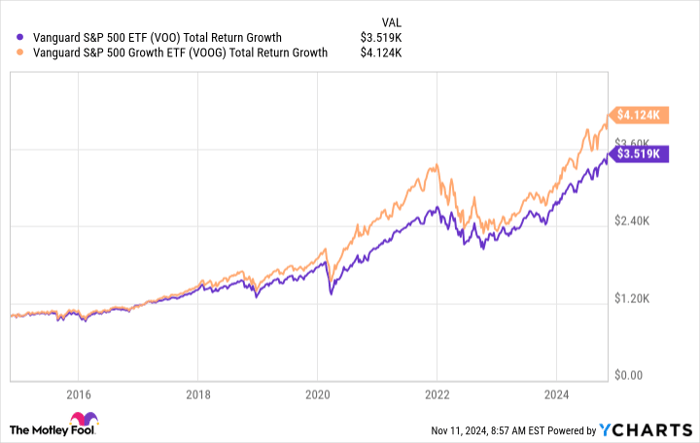Exchange-traded funds (ETFs) offer some major benefits for investors. Like stocks, you can buy as much or as little of an ETF as you want, but they also provide excellent diversification that eases risk and provides a ready-made portfolio for the careful investor.
Not all ETFs are created alike. Some are incredibly diverse, with thousands of stocks in their portfolios, while others are focused on single themes and may have fewer than 100 stocks. That's especially true of many growth-focused ETFs, which may spread risk by owning several stocks, but are still much riskier than larger and broader funds.
If you're looking for a top growth ETF that comes with excellent growth prospects, a strong track record, and low risk, I highly recommend the Vanguard S&P 500 Growth ETF (NYSEMKT: VOOG).
Why you might love this ETF
As the name suggests, this ETF is focused on creating high growth for investors. And it has delivered phenomenally over both the short and long terms. It's up 35% this year, beating the S&P 500 by a wide margin, and it has an annualized gain of 16% since its inception, versus about 14.5% for the broader index.
That might sound minimal, but it adds up over time. If you had invested $1,000 in both the standard Vanguard S&P 500 ETF and the growth ETF 10 years ago, here's what you would have today.
VOO total return level; data by YCharts.
The ETF, like all Vanguard ETFs, is a passively managed fund that follows an index. In this case, it's the S&P 500 growth index, which is a group of around 230 stocks. Its top holdings include Apple, Microsoft, Nvidia, and Amazon, and since it's a weighted index, those four stocks alone account for more than 40% of the portfolio.
However, the more than 200 other stocks are all well-established and aren't high-risk types such as initial public offerings. Some of its smallest holdings are companies like Ulta Beauty and Hershey.
Something else to note is that Vanguard's ETFs have very low expense ratios, which is the amount of money you pay for the company's service. Actively managed funds usually have higher expense ratios, but Vanguard's are always low compared with similar funds.
The Growth ETF's expense ratio is 0.10%, compared with 0.94% for similar funds. It's in the middle compared with Vanguard's other ETFs, whose expense ratios range from 0.03% to 20%, but it has the second-highest annualized gains since inception.
What are the risks?
The growth ETF is riskier than the standard S&P 500 ETF because it's more concentrated in general -- with less than half the number of the companies in the broader ETF -- and because the concentration is in growth stocks, which are usually riskier than other classes. It's also highly exposed to a small number of stocks, and if something happens to one of them, the ETF will feel the effect deeply.

Image source: Getty Images.
However, these risks are somewhat moderated because the growth ETF follows an index, and risky or poor-performing stocks can easily be traded out in favor of better picks. That's the beauty of index investing: The odds are heavily in your favor, because the stocks can be easily switched.
Part of the appeal of an index fund is the diversification, and although 230 stocks are quite a lot, it's less than some of the other Vanguard ETFs that follow indexes with thousands of stocks. One strong strategy is to accompany any growth investing with a position in the classic S&P 500 ETF, providing the opportunity for higher growth with the fortification of wider index investing.
Why now?
If you could buy only one ETF right now, I would still recommend the Vanguard Growth ETF. The long-term risk is minimal, and the rewards are high. Also, the stock market is buoyant after the election, and as inflation moderates, we might be on the cusp of an even stronger market.
There are always going to be ups and downs, and having a strong index fund provides security and growth prospects to help you get to retirement with a well-padded nest egg.
Don’t miss this second chance at a potentially lucrative opportunity
Ever feel like you missed the boat in buying the most successful stocks? Then you’ll want to hear this.
On rare occasions, our expert team of analysts issues a “Double Down” stock recommendation for companies that they think are about to pop. If you’re worried you’ve already missed your chance to invest, now is the best time to buy before it’s too late. And the numbers speak for themselves:
- Amazon: if you invested $1,000 when we doubled down in 2010, you’d have $23,529!*
- Apple: if you invested $1,000 when we doubled down in 2008, you’d have $42,465!*
- Netflix: if you invested $1,000 when we doubled down in 2004, you’d have $441,949!*
Right now, we’re issuing “Double Down” alerts for three incredible companies, and there may not be another chance like this anytime soon.
*Stock Advisor returns as of November 11, 2024
John Mackey, former CEO of Whole Foods Market, an Amazon subsidiary, is a member of The Motley Fool's board of directors. Jennifer Saibil has positions in Apple. The Motley Fool has positions in and recommends Amazon, Apple, Hershey, Microsoft, Nvidia, Ulta Beauty, and Vanguard S&P 500 ETF. The Motley Fool recommends the following options: long January 2026 $395 calls on Microsoft and short January 2026 $405 calls on Microsoft. The Motley Fool has a disclosure policy.
The views and opinions expressed herein are the views and opinions of the author and do not necessarily reflect those of Nasdaq, Inc.



